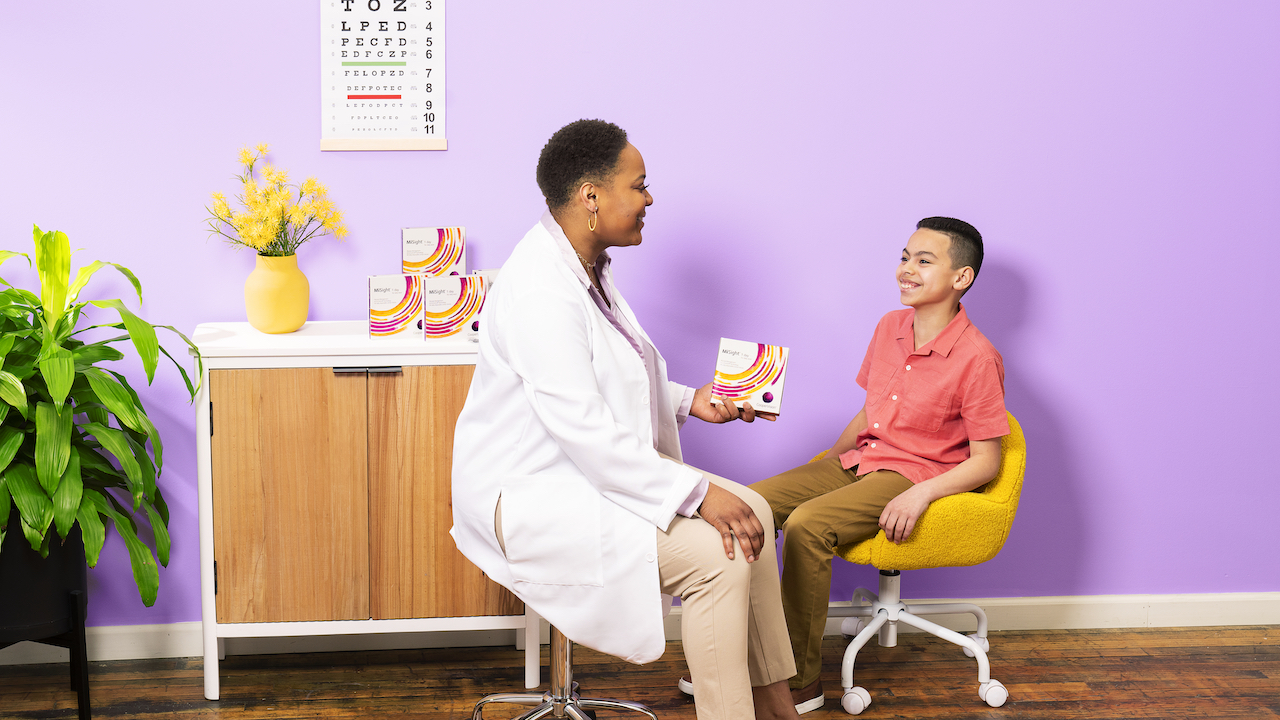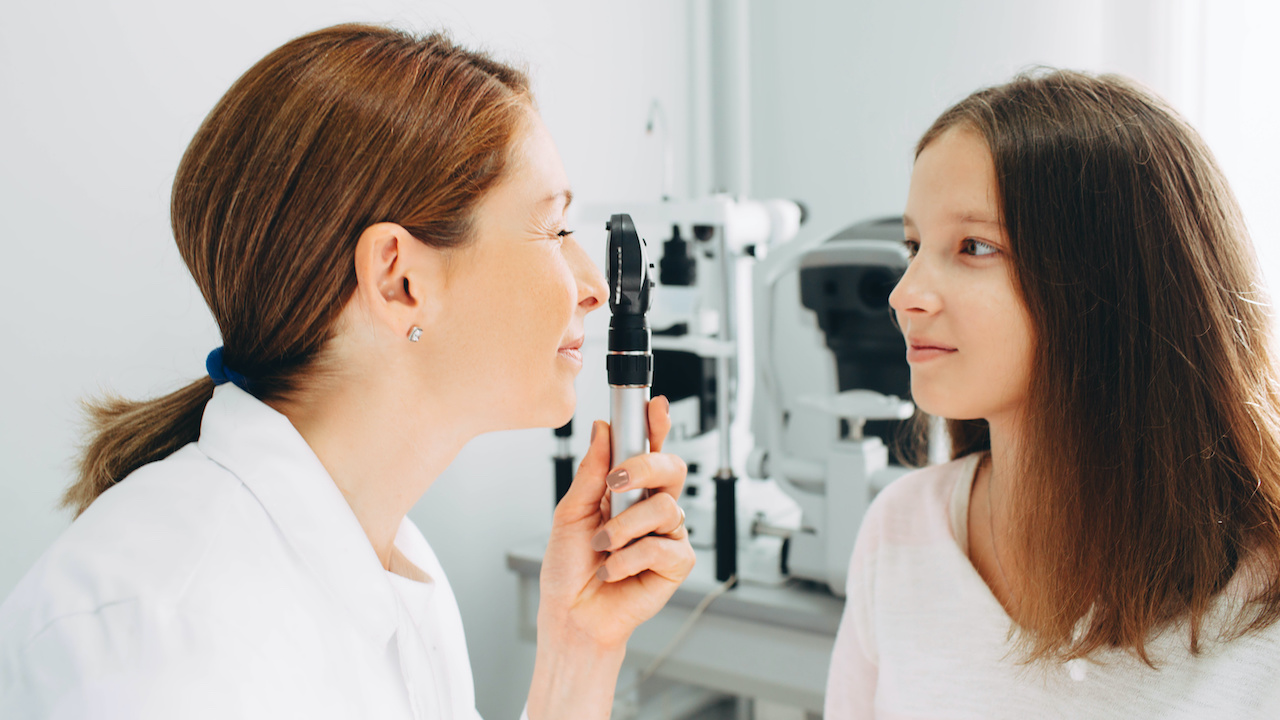Nearsightedness, also called myopia, is on the rise in children. Find out why and how to help.
Created for ![]()
Parents practically have back-to-school down to a science. Backpack? Check. Proper footwear? Got ‘em. Lunchboxes and many, many lunch ideas? You bet. But did you know that you should be adding getting an eye exam to the list of things your kids need before school starts? It’s important not only for general eye health but also because nearsightedness in children has increased dramatically in recent years1. Also called myopia, this eye condition means that while you can see objects close to you clearly, objects that are further away are blurry. It often begins in childhood and adolescence and worsens to about the age of 20. According to one recent study of more than 120,000 children, the prevalence of myopia increased up to three times in 2020 compared to the previous five years and was especially noted in children ages six to eight2.
What causes myopia?
Myopia happens when the length of the eyeball grows too long, or the cornea (the transparent part of the eye that covers the iris and pupil) is too curved, causing the light that enters the eye to not focus properly on the retina (the sensory layer within the eye). While family history is a part of it—a child has a one in three chance of developing nearsightedness if one parent is also nearsighted3—lifestyle factors also play a role. Spending a great deal of time indoors4,5, using your near vision (looking at things close up) a lot through reading and having lots of screen time with devices like tablets or smartphones6, and poor lighting7 can all also contribute to the development of myopia. So, what’s one of the unintended outcomes of the pandemic’s extra indoor time, more-than-usual screen time, and at-home online learning? It’s a significant uptick in kids with myopia8.
What are the signs and symptoms of myopia?
A child with myopia may talk about far-away objects looking blurry or not being able to see a TV screen, movie screen or school whiteboard. They may squint often, blink a lot, rub their eyes frequently or seem to be unaware of distant objects. Sometimes, headaches occur due to eyestrain. However, because a child may think blurry is just normal, they may not mention any issues at all. That’s one reason it’s essential to have regular checkups with an eye care professional who can identify potential problems.
While fuzzy vision can lead to challenges at school or during sports and other extracurricular activities, untreated myopia can also lead to serious sight-threatening eye health issues later in life, including glaucoma and cataracts8. To see what the world looks like with myopia, check out this myopia simulator.
Regular eye health and exams
Fortunately, taking action by treating myopia while your child is young goes a long way in reducing risk down the road. For example, relaxing and playing outdoors, going to bed earlier, using proper lighting, and regular breaks from near-vision activities like reading and screen time are all good for eye health. An annual eye exam with an optometrist is a fast and effective way to detect various eye conditions and vision problems—not just myopia—so be sure to make that part of your back-to-school planning. Set your child up for a bright, clear future!

New contact lenses for kids
Ordinary prescription eyeglasses and contact lenses can help your child see distant objects more clearly right away, but unfortunately, they do not reduce the progression of myopia. There is good news, though: There is now a dual-purpose product that can do more—CooperVision’s MiSight® 1 day contact lenses provide clear vision and help to control the progression of myopia in age-appropriate children9.
- MiSight® 1 day contact lenses are easy-to-use10, single-use soft contacts, which are disposed of at the end of each day.
- They’ve been clinically proven safe10and, over three years, slowed the rate of myopia progression by 59 percent, on average†§11. Even better, 41 percent of eyes showed no myopia progression at 3 years†¶12.
- They’re also the first and only soft contact lenses that are FDA-approved*to slow myopia progression in children aged eight to 12 at the initiation of treatment†12.
- They’re kid-approved: After using MiSight® 1 day contact lenses for three years, 90 percent of children still strongly preferred them over their glasses13, and 90 percent of parents reported that their child was happy wearing their MiSight® 1 day contact lenses±14.
†Compared to a single vision 1 day lens over a three-year period.
§Children aged 8-12 at the initiation of treatment.
¶No clinically meaningful change in refractive error -0.25D or less from baseline.
µ95% – 100% of children expressed a preference for contact lenses over glasses at each visit over 36 months
±Overall experience as defined as children’s comfort, vision, lens handling, and freedom from spectacles. Children aged 8-15 years.
Indications and Important Safety Information. Rx only. Results may vary.
ATTENTION: *USA Indication: MiSight® 1 day (omafilcon A) soft (hydrophilic) contact lenses for daily wear are indicated for the correction of myopic ametropia and for slowing the progression of myopia in children with non-diseased eyes, who at the initiation of treatment are 8-12 years of age and have a refraction of -0.75 to -4.00 diopters (spherical equivalent) with ≤ 0.75 diopters of astigmatism. The lens is to be discarded after each removal. Canadian Indication: MiSight (omafilcon A) Soft Contact Lenses for Myopia Control are indicated for the correction of ametropia (myopia and hyperopia) in aphakic and non-aphakic persons with non-diseased eyes in powers from -20.00D to +2.00 diopters. The lenses may be worn by persons who exhibit astigmatism of -2.00 diopters or less that does not interfere with visual acuity. MiSight (omafilcon A) Soft Contact Lenses for Myopia Control may reduce the rate of myopia progression in children (6-18) and correct ametropia. Reduction of myopia progression was observed in children with wearing time of 12 hours (8-16 hours) per day, 6.4 days (5-7) per week in a clinical study. Permanent myopia control after lens treatment is discontinued is not supported by clinical studies. MiSight (omafilcon A) Soft Contact Lenses for Myopia Control are indicated for single-use daily disposable wear. When prescribed for daily disposable wear, the lens is to be discarded after each removal. Warnings: Problems with contact lenses could result in serious injury to the eye. Do not expose contact lenses to water while wearing them. No overnight wear. Patients should exercise extra care if performing potentially hazardous activities. Adverse events: Including but not limited to infection/inflammation/ulceration/abrasion of the cornea, other parts of the eye or eyelids. Some of these adverse reactions can cause permanent or temporary loss of vision. If you notice any of the stated adverse reactions in your child, immediately have your child remove the lenses and contact your eye care professional.
References
- Kuehn BM. Increase in Myopia Reported Among Children During COVID-19 Lockdown. JAMA. 2021;326(11):999. doi:10.1001/jama.2021.14475
- Wang J, Li Y, Musch DC, et al. Progression of Myopia in School-Aged Children After COVID-19 Home Confinement. JAMA Ophthalmol. 2021;139(3):293–300. doi:10.1001/jamaophthalmol.2020.6239
- Morgan P. Is Myopia Control the Next Contact Lens Revolution? The Optician 2016
- Wolffsohn JS, Calossi A, Cho P, et al. Global Trends in Myopia Management Attitudes and Strategies in Clinical Practice. Cont Lens Anterior Eye. 2016; 39:106-16.
- Rose KA, Morgan IG, Ip J, et al. Outdoor Activity Reduces the Prevalence of Myopia in Children. Ophthalmology 2008; 115:1279-1285.
- Wolffsohn JS, Calossi A, Cho P, et al. Global Trends in Myopia Management Attitudes and Strategies in Clinical Practice. Cont Lens Anterior Eye. 2016; 39:106-16.
- Gifford P, Gifford KL. The Future of Myopia Control Contact Lenses. Optom Vis Sci.; 93:336-43.
- Flitcroft DI. The complex interactions of retinal, optical, and environmental factors in myopia aetiology Prog Retin Eye Res. 2012;31(6):622-660.
- Chamberlain P et al A 3-year Randomized Clinical Trial of MiSight Lenses for Myopia Control. Optom Vis Sci 2019;96:556-567.
- Woods, J., Jones, D., Jones, L., Jones, S., Hunt, C., Chamberlain, P., & McNally, J. (2021). Ocular health of children wearing daily disposable contact lenses over a 6-year period. Contact Lens and Anterior Eye
- Chamberlain P, et al. A 3-year randomized clinical trial of MiSight® lenses for myopia control. Optom Vis Sci. 2019; 96(8):556-567.
- Chamberlain P, Arumugam B, Jones D et al. Myopia Progression in Children wearing Dual-Focus Contact Lenses: 6-year findings. Optom Vis Sci 2020;97(E-abstract): 200038
- Sulley A et al. Wearer experience and subjective responses with dual focus compared to spherical, single vision soft contact lenses in children during a 3-year clinical trial. AAO 2019 Poster Presentation.
- CVI data on file 2018. 3- year study report.

 PARENTING TIPS
PARENTING TIPS PREGNANCY
PREGNANCY BABY CARE
BABY CARE TODDLERS
TODDLERS TEENS
TEENS HEALTH CARE
HEALTH CARE ACTIVITIES & CRAFTS
ACTIVITIES & CRAFTS


